Persephone
| Persephone | |
|---|---|
Queen of the Underworld Goddess of death, life, grain, and destruction | |
 | |
| Abode | The underworld, Sicily, Mount Olympus |
| Symbol | Pomegranate, seeds of grain, torch, flowers and deer |
| Personal information | |
| Parents | Zeus and Demeter, Zeus and Rhea (Orphic)[4] |
| Siblings | Aeacus, Angelos, Aphrodite, Apollo, Ares, Arion, Artemis, Athena, Chrysothemis, Despoina, Dionysus, Eileithyia, Enyo, Eris, Ersa, Eubuleus, Hebe, Helen of Troy, Hephaestus, Heracles, Hermes, Minos, Pandia, Philomelus, Plutus, Perseus, Rhadamanthus, the Graces, the Horae, the Litae, the Muses, the Moirai |
| Spouse | Hades |
| Children | Melinoë, Plutus (Orphic), Zagreus/Dionysus (Orphic)[1][2][3] |
| Roman equivalent | Proserpina |
| Part of a series on |
| Ancient Greek religion |
|---|
 |
|
In Greek mythology, Persephone (/pərˈsɛfəniː/ pər-SEF-ə-nee; Greek: Περσεφόνη, romanized: Persephónē), also called Kore or Kora (/ˈkɔːriː/ KOR-ee; Greek: Κόρη, romanized: Kórē, lit. 'the maiden'), is the daughter of Zeus and Demeter. She became the queen of the underworld after her abduction by Hades, the god of the underworld, with the approval of her father, Zeus.[5] The myth of her abduction, her sojourn in the underworld and her temporary return to the surface represents her functions as the embodiment of spring and the personification of vegetation, especially grain crops, which disappear into the earth when sown, sprout from the earth in spring, and are harvested when fully grown. In Classical Greek art, Persephone is invariably portrayed robed, often carrying a sheaf of grain. She may appear as a mystical divinity with a sceptre and a little box, but she was mostly represented in the process of being carried off by Hades.
Persephone as a vegetation goddess and her mother Demeter were the central figures of the Eleusinian mysteries, which promised the initiated a happy afterlife. The origins of her cult are uncertain, but it was based on ancient agrarian cults of agricultural communities. In Athens, the mysteries celebrated in the month of Anthesterion were dedicated to her.
Her name has numerous historical variants. These include Persephassa (Περσεφάσσα) and Persephatta (Περσεφάττα). In Latin, her name is rendered Proserpina. She was identified by the Romans as the Italic goddess Libera, who was conflated with Proserpina. Myths similar to Persephone's descent and return to earth also appear in the cults of male gods like Attis, Adonis, and Osiris,[6] and in Minoan Crete.
Name[]

In a Linear B Mycenaean Greek inscription on a tablet found at Pylos dated 1400–1200 BC, John Chadwick reconstructed[n 1] the name of a goddess, *Preswa who could be identified with Perse, daughter of Oceanus and found speculative the further identification with the first element of Persephone.[8][9] Persephonē (Greek: Περσεφόνη) is her name in the Ionic Greek of epic literature. The Homeric form of her name is Persephoneia (Περσεφονεία,[10] Persephoneia). In other dialects, she was known under variant names: Persephassa (Περσεφάσσα), Persephatta (Περσεφάττα), or simply Korē (Κόρη, "girl, maiden").[11] Plato calls her Pherepapha (Φερέπαφα) in his Cratylus, "because she is wise and touches that which is in motion". There are also the forms Periphona (Πηριφόνα) and Phersephassa (Φερσέφασσα). The existence of so many different forms shows how difficult it was for the Greeks to pronounce the word in their own language and suggests that the name may have a Pre-Greek origin.[12]
Persephatta (Περσεφάττα) is considered to mean "female thresher of grain"; the first constituent of the name originates in Proto-Greek "perso-" (related to Sanskrit "parṣa-"), "sheaf of grain" and the second constituent of the name originates in Proto-Indo European *-gʷn-t-ih, from the root *gʷʰen- "to strike".[13]
A popular folk etymology is from φέρειν φόνον, pherein phonon, "to bring (or cause) death".[14]
Titles and functions[]
The epithets of Persephone reveal her double function as chthonic (underworld) and vegetation goddess. The surnames given to her by the poets refer to her character as Queen of the lower world and the dead, or her symbolic meaning of the power that shoots forth and withdraws into the earth. Her common name as a vegetation goddess is Kore, and in Arcadia she was worshipped under the title Despoina, "the mistress", a very old chthonic divinity.[14]
Goddess of Spring and Nature[]
Plutarch writes that Persephone was identified with a spring season[15] and Cicero calls her the seed of the fruits of the fields. In the Eleusinian Mysteries, her return from the underworld each spring is a symbol of immortality, and hence she was frequently represented on sarcophagi.
In the religions of the Orphics and the Platonists, Kore is described as the all-pervading goddess of nature[16] who both produces and destroys everything, and she is therefore mentioned along with or identified as other such divinities including Isis, Rhea, Ge, Hestia, Pandora, Artemis, and Hecate.[17] In Orphic tradition, Persephone is said to be the daughter of Zeus and his mother Rhea, rather than of Demeter.[18] The Orphic Persephone is said to have become by Zeus the mother of Dionysus, Iacchus, Zagreus,[14] and the little-attested Melinoe.[19]
Goddess of the Underworld[]
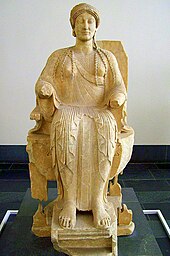
In mythology and literature she is often called dread(ed) Persephone, and queen of the Underworld, within which tradition it was forbidden to speak her name. This tradition comes from her conflation with the very old chthonic divinity Despoina ("[the] mistress"), whose real name could not be revealed to anyone except those initiated into her mysteries.[20] As goddess of death, she was also called a daughter of Zeus and Styx,[21] the river that formed the boundary between Earth and the underworld. In Homer's epics, she appears always together with Hades and the Underworld, apparently sharing with Hades control over the dead.[22] In Homer's Odyssey, Odysseus encounters the "dread Persephone" in Tartarus when he visits his dead mother. Odysseus sacrifices a ram to the chthonic goddess Persephone and the ghosts of the dead who drink the blood of the sacrificed animal. In the reformulation of Greek mythology expressed in the Orphic Hymns, Dionysus and Melinoe are separately called children of Zeus and Persephone.[23] Groves sacred to her stood at the western extremity of the earth on the frontiers of the lower world, which itself was called "house of Persephone".[24]
Her central myth served as the context for the secret rites of regeneration at Eleusis,[25] which promised immortality to initiates.
Nestis[]
In a Classical period text ascribed to Empedocles, c. 490–430 BC,[n 2] describing a correspondence among four deities and the classical elements, the name Nestis for water apparently refers to Persephone: "Now hear the fourfold roots of everything: enlivening Hera, Hades, shining Zeus. And Nestis, moistening mortal springs with tears."[26]
Of the four deities of Empedocles' elements, it is the name of Persephone alone that is taboo—Nestis is a euphemistic cult title[n 3]—for she was also the terrible Queen of the Dead, whose name was not safe to speak aloud, who was euphemistically named simply as Kore or "the Maiden", a vestige of her archaic role as the deity ruling the underworld. Nestis means "the Fasting One" in ancient Greek.[citation needed]
Epithets[]
As a goddess of the underworld, Persephone was given euphemistically friendly names.[27] However it is possible that some of them were the names of original goddesses:
- Despoina (dems-potnia) "the mistress" (literally "the mistress of the house") in Arcadia.
- Hagne, "pure", originally a goddess of the springs in Messenia.[28]
- Melindia or Melinoia (meli, "honey"), as the consort of Hades, in Hermione. (Compare Hecate, Melinoe)[27]
- Malivina[27]
- Melitodes[27]
- Aristi cthonia, "the best chthonic".[27]
- Praxidike, the Orphic Hymn to Persephone identifies Praxidike as an epithet of Persephone: "Praxidike, subterranean queen. The Eumenides' source [mother], fair-haired, whose frame proceeds from Zeus' ineffable and secret seeds."[29][30]
As a vegetation goddess, she was called:[28][31]
- Kore, "the maiden".
- Kore Soteira, "the savior maiden", in Megalopolis.
- Neotera, "the younger", in Eleusis.
- Kore of Demeter Hagne in the Homeric hymn.
- Kore memagmeni, "the mixed daughter" (bread).
Demeter and her daughter Persephone were usually called:[31][32]
- The goddesses, often distinguished as "the older" and "the younger" in Eleusis.
- Demeters, in Rhodes and Sparta
- The thesmophoroi, "the legislators" in the Thesmophoria.
- The Great Goddesses, in Arcadia.
- The mistresses in Arcadia.[33]
- Karpophoroi, "the bringers of fruit", in Tegea of Arcadia.
Mythology[]
Abduction myth[]

Persphone's abduction by Hades[n 4] is mentioned briefly in Hesiod's Theogony,[34] and is told in considerable detail in the Homeric Hymn to Demeter. Zeus, it is said, permitted Hades, who was in love with the beautiful Persephone, to abduct her as her mother Demeter was not likely to allow her daughter to go down to Hades. Persephone was gathering flowers with the Oceanids along with Artemis and Pallas, daughter of Triton, as the Homeric Hymn says, in a field when Hades came to abduct her, bursting through a cleft in the earth.[35] Demeter, when she found her daughter had disappeared, searched for her all over the earth with Hecate's torches. In most versions, she forbids the earth to produce, or she neglects the earth and, in the depth of her despair, she causes nothing to grow. Helios, the sun, who sees everything, eventually told Demeter what had happened and at length she discovered the place of her abode. Finally, Zeus, pressed by the cries of the hungry people and by the other deities who also heard their anguish, forced Hades to return Persephone.[36]

Hades complies with the request, but first he tricks Persephone, giving her some pomegranate seeds to eat.[37] Hermes is sent to retrieve her but, because she had tasted the food of the underworld, she was obliged to spend a third of each year (the winter months) there, and the remaining part of the year with the gods above.[38] With the later writers Ovid and Hyginus, Persephone's time in the underworld becomes half the year.[39] It was explained to Demeter, her mother, that she would be released, so long as she did not taste the food of the Underworld.
Various local traditions place Persephone's abduction in different locations. The Sicilians, among whom her worship was probably introduced by the Corinthian and Megarian colonists, believed that Hades found her in the meadows near Enna, and that a well arose on the spot where he descended with her into the lower world. The Cretans thought that their own island had been the scene of the abduction, and the Eleusinians mentioned the Nysian plain in Boeotia, and said that Persephone had descended with Hades into the lower world at the entrance of the western Oceanus. Later accounts place the abduction in Attica, near Athens, or near Eleusis.[36] The Homeric hymn mentions the Nysion (or Mysion) which was probably a mythical place. The location of this mythical place may simply be a convention to show that a magically distant chthonic land of myth was intended in the remote past.[31]
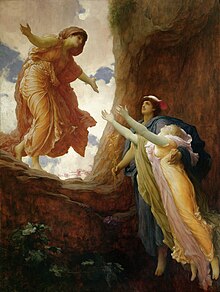
Before Persephone was abducted by Hades, the shepherd Eumolpus and the swineherd Eubuleus saw a girl in a black chariot driven by an invisible driver being carried off into the earth which had violently opened up. Eubuleus was feeding his pigs at the opening to the underworld, and his swine were swallowed by the earth along with her. This aspect of the myth is an etiology for the relation of pigs with the ancient rites in Thesmophoria,[40] and in Eleusis.
In the hymn, Persephone eventually returns from the underworld and is reunited with her mother near Eleusis. The Eleusinians built a temple near the spring of Callichorus, and Demeter establishes her mysteries there.[n 5]
In some versions, Ascalaphus informed the other deities that Persephone had eaten the pomegranate seeds. When Demeter and her daughter were reunited, the Earth flourished with vegetation and color, but for some months each year, when Persephone returned to the underworld, the earth once again became a barren realm. This is an origin story to explain the seasons.
In an earlier version, Hecate rescued Persephone. On an Attic red-figured bell krater of c. 440 BC in the Metropolitan Museum of Art, Persephone is rising as if up stairs from a cleft in the earth, while Hermes stands aside; Hecate, holding two torches, looks back as she leads her to the enthroned Demeter.[41]
The 10th-century Byzantine encyclopedia Suda introduces a goddess of a blessed afterlife assured to Orphic mystery initiates. This Macaria is asserted to be the daughter of Hades, but no mother is mentioned.[42]
Interpretation of the myth[]
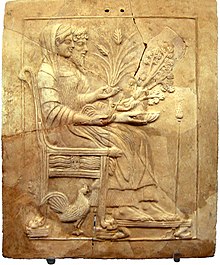
In the myth describing the origin of their marriage, Hades abducts Persephone to be his wife and the queen of his realm.[43]
This etiological myth analogizes is the changing of the seasons: since Persephone had consumed six pomegranate seeds in the Underworld, she was forced to spend six months or half of the year with Hades.[44] When Persephone would return to the Underworld, Demeter��s despair at losing her daughter would cause the vegetation and flora of the world to wither, signifying the Autumn and Winter seasons. When Persephone’s time is over and she would be reunited with her mother, Demeter’s joyousness would cause the vegetation of the earth to bloom and blossom which signifies the Spring and Summer seasons. This also explains why Persephone is associated with Spring: her re-emergence from the Underworld signifies the onset of Spring. Therefore, not only does Persephone and Demeter’s annual reunion symbolize the changing seasons and the beginning of a new cycle of growth for the crops, it also symbolizes death and the regeneration of life.[45][46][citation needed]
In another interpretation of the myth, the abduction of Persephone by Hades, in the form of Ploutus (πλούτος, wealth), represents the wealth of the grain contained and stored in underground silos or ceramic jars (pithoi) during the Summer seasons (as that was drought season in Greece).[47] In this telling, Persephone as grain-maiden symbolizes the grain within the pithoi that is trapped underground within the realm of Hades. In the beginning of the autumn, when the grain of the old crop is laid on the fields, she ascends and is reunited with her mother Demeter.[48][45][49] This interpretation of Persephone's abduction myth symbolizes the cycle of life and death as Persephone both dies as she (the grain) is buried in the pithoi (as similar pithoi were used in ancient times for funerary practices) and is reborn with the exhumation and spreading of the grain.
Arcadian myths[]

According to the Greek tradition a hunt-goddess preceded the harvest goddess.[50] In Arcadia, Demeter and Persephone were often called Despoinai (Δέσποιναι, "the mistresses"). They are the two Great Goddesses of the Arcadian cults, and evidently they come from a more primitive religion.[31] The Greek god Poseidon probably substituted for the companion (Paredros, Πάρεδρος) of the Minoan Great goddess[51] in the Arcadian mysteries.
Worship[]
Persephone was worshipped along with her mother Demeter and in the same mysteries. Her cults included agrarian magic, dancing, and rituals. The priests used special vessels and holy symbols, and the people participated with rhymes. In Eleusis there is evidence of sacred laws and other inscriptions.[52]
The Cult of Demeter and the Maiden is found at Attica, in the main festivals Thesmophoria and Eleusinian mysteries and in a number of local cults. These festivals were almost always celebrated at the autumn sowing, and at full-moon according to the Greek tradition. In some local cults the feasts were dedicated to Demeter.
Origins[]

The myth of a goddess being abducted and taken to the Underworld is probably Pre-Greek in origin. Samuel Noah Kramer, the renowned scholar of ancient Sumer, has posited that the Greek story of the abduction of Persephone may be derived from an ancient Sumerian story in which Ereshkigal, the ancient Sumerian goddess of the Underworld, is abducted by Kur, the primeval dragon of Sumerian mythology, and forced to become ruler of the Underworld against her own will.[53]
The location of Persephone's abduction is different in each local cult. The Homeric Hymn to Demeter mentions the "plain of Nysa".[54] The locations of this probably mythical place may simply be conventions to show that a magically distant chthonic land of myth was intended in the remote past.[55][56] Demeter found and met her daughter in Eleusis, and this is the mythical disguise of what happened in the mysteries.[57]
In his 1985 book on Greek Religion, Walter Burkert claimed that Persephone is an old chthonic deity of the agricultural communities, who received the souls of the dead into the earth, and acquired powers over the fertility of the soil, over which she reigned. The earliest depiction of a goddess Burkert claims may be identified with Persephone growing out of the ground, is on a plate from the Old-Palace period in Phaistos. According to Burkert, the figure looks like a vegetable because she has snake lines on other side of her. On either side of the vegetable person there is a dancing girl.[58] A similar representation, where the goddess appears to come down from the sky, is depicted on the Minoan ring of Isopata.
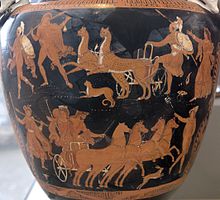
The cults of Persephone and Demeter in the Eleusinian mysteries and in the Thesmophoria were based on old agrarian cults.[59] The beliefs of these cults were closely-guarded secrets, kept hidden because they were believed to offer believers a better place in the afterlife than in miserable Hades. There is evidence that some practices were derived from the religious practices of the Mycenaean age.[60][58] Kerenyi asserts that these religious practices were introduced from Minoan Crete.[61][62] The idea of immortality which appears in the syncretistic religions of the Near East did not exist in the Eleusinian mysteries at the very beginning.[63][64]
In the Near East and Minoan Crete[]
Walter Burkert believed that elements of the Persephone myth had origins in the Minoan religion. This belief system had unique characteristics, particularly the appearance of the goddess from above in the dance. Dance floors have been discovered in addition to "vaulted tombs", and it seems that the dance was ecstatic. Homer memorializes the dance floor which Daedalus built for Ariadne in the remote past.[65] A gold ring from a tomb in Isopata depicts four women dancing among flowers, the goddess floating above them.[66] An image plate from the first palace of Phaistos seems to depict the ascent of Persephone: a figure grows from the ground, with a dancing girl on each side and stylized flowers all around.[58] The depiction of the goddess is similar to later images of "Anodos of Pherephata". On the Dresden vase, Persephone is growing out of the ground, and she is surrounded by the animal-tailed agricultural gods Silenoi.[67]
Despoina and "Hagne" were probably euphemistic surnames of Persephone, therefore Karl Kerenyi theorizes that the cult of Persephone was the continuation of the worship of a Minoan Great goddess.[68][69] It is possible that some religious practices, especially the mysteries, were transferred from a Cretan priesthood to Eleusis, where Demeter brought the poppy from Crete.[70] Besides these similarities, Burkert explains that up to now it is not known to what extent one can and must differentiate between Minoan and Mycenean religion.[71] In the Anthesteria Dionysos is the "divine child".
In Mycenaean Greece[]
There is evidence of a cult in Eleusis from the Mycenean period;[72] however, there are not sacral finds from this period. The cult was private and there is no information about it. As well as the names of some Greek gods in the Mycenean Greek inscriptions, also appear names of goddesses, like "the divine Mother" (the mother of the gods) or "the Goddess (or priestess) of the winds", who don't have Mycenean origin .[57] In historical times, Demeter and Kore were usually referred to as "the goddesses" or "the mistresses" (Arcadia) in the mysteries .[73] In the Mycenean Greek tablets dated 1400–1200 BC, the "two queens and the king" are mentioned. John Chadwick believes that these were the precursor divinities of Demeter, Persephone and Poseidon.[74][75]
Some information can be obtained from the study of the cult of Eileithyia at Crete, and the cult of Despoina. In the cave of Amnisos at Crete, Eileithyia is related with the annual birth of the divine child and she is connected with Enesidaon (The earth shaker), who is the chthonic aspect of the god Poseidon.[76] Persephone was conflated with Despoina, "the mistress", a chthonic divinity in West-Arcadia.[62] The megaron of Eleusis is quite similar with the "megaron" of Despoina at Lycosura.[57] Demeter is united with her, the god Poseidon, and she bears him a daughter, the unnameable Despoina.[77] Poseidon appears as a horse, as it usually happens in Northern European folklore. The goddess of nature and her companion survived in the Eleusinian cult, where the following words were uttered "Mighty Potnia bore a great sun".[76] In Eleusis, in a ritual, one child ("pais") was initiated from the hearth. The name pais (the divine child) appears in the Mycenean inscriptions.[57]
In Greek mythology Nysa is a mythical mountain with an unknown location.[56] Nysion (or Mysion), the place of the abduction of Persephone was also probably a mythical place which did not exist on the map, a magically distant chthonic land of myth which was intended in the remote past.[78]
Secret rituals and festivals[]

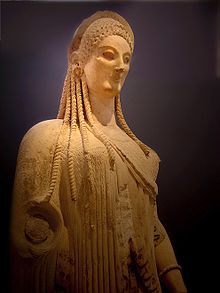
Persephone and Demeter were intimately connected with the Thesmophoria, a widely-spread Greek festival of secret women-only rituals. These rituals, which were held in the month Pyanepsion, commemorated marriage and fertility, as well as the abduction and return of Persephone.
They were also involved in the Eleusinian mysteries, a festival celebrated at the autumn sowing in the city of Eleusis. Inscriptions refer to "the Goddesses" accompanied by the agricultural god Triptolemos (probably son of Gaia and Oceanus),[79] and "the God and the Goddess" (Persephone and Plouton) accompanied by Eubuleus who probably led the way back from the underworld.[80]
In Rome[]
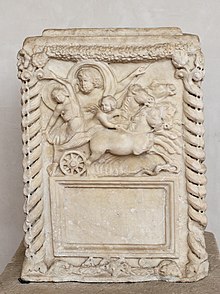
The Romans first heard of her from the Aeolian and Dorian cities of Magna Graecia, who used the dialectal variant Proserpinē (Προσερπίνη). Hence, in Roman mythology she was called Proserpina, a name erroneously derived by the Romans from proserpere, "to shoot forth"[81] and as such became an emblematic figure of the Renaissance.[82] In 205 BC, Rome officially identified Proserpina with the local Italic goddess Libera, who, along with Liber, were strongly associated with the Roman grain goddess Ceres (considered equivalent to the Greek Demeter). The Roman author Gaius Julius Hyginus also considered Proserpina equivalent to the Cretan goddess Ariadne, who was the bride of Liber's Greek equivalent, Dionysus.[83][84]
In Magna Graecia[]
At Locri, a city of Magna Graecia situated on the coast of the Ionian Sea in Calabria (a region of southern Italy), perhaps uniquely, Persephone was worshiped as protector of marriage and childbirth, a role usually assumed by Hera; in the iconography of votive plaques at Locri, her abduction and marriage to Hades served as an emblem of the marital state, children at Locri were dedicated to Proserpina, and maidens about to be wed brought their peplos to be blessed.[85] Diodorus Siculus knew the temple there as the most illustrious in Italy.[86] During the 5th century BC, votive pinakes in terracotta were often dedicated as offerings to the goddess, made in series and painted with bright colors, animated by scenes connected to the myth of Persephone. Many of these pinakes are now on display in the National Museum of Magna Græcia in Reggio Calabria. Locrian pinakes represent one of the most significant categories of objects from Magna Graecia, both as documents of religious practice and as works of art.[87]
The temple at Lorci was looted by Pyrrhus.[88] The importance of the regionally powerful Lokrian Persephone influenced the representation of the goddess in Magna Graecia. Pinakes, terracotta tablets with brightly painted sculptural scenes in relief were founded in Locri. The scenes are related to the myth and cult of Persephone and other deities. They were produced in Locri during the first half of the 5th century BC and offered as votive dedications at the Locrian sanctuary of Persephone. More than 5,000, mostly fragmentary, pinakes are stored in the National Museum of Magna Græcia in Reggio Calabria and in the museum of Locri.[87] Representations of myth and cult on the clay tablets (pinakes) dedicated to this goddess reveal not only a 'Chthonian Queen,’ but also a deity concerned with the spheres of marriage and childbirth.[86]
The Italian archaeologist Paolo Orsi, between 1908 and 1911, carried out a meticulous series of excavations and explorations in the area which allowed him to identify the site of the renowned Persephoneion, an ancient temple dedicated to Persephone in Calabria which Diodorus in his own time knew as the most illustrious in Italy.[89]
The place where the ruins of the Sanctuary of Persephone were brought to light is located at the foot of the Mannella hill, near the walls (upstream side) of the polis of Epizephyrian Locri. Thanks to the finds that have been retrieved and to the studies carried on, it has been possible to date its use to a period between the 7th century BC and the 3rd century BC.
Archaeological finds suggest that worship of Demeter and Persephone was widespread in Sicily and Greek Italy.
In Orphism[]
Evidence from both the Orphic Hymns and the Orphic Gold Leaves demonstrate that Persephone was one of the most important deities worshiped in Orphism.[90] In the Orphic religion, gold leaves with verses intended to help the deceased enter into an optimal afterlife were often buried with the dead. Persephone is mentioned frequently in these tablets, along with Demeter and Euklês, which may be another name for Plouton.[90] The ideal afterlife destination believers strive for is described on some leaves as the "sacred meadows and groves of Persephone". Other gold leaves describe Persephone's role in receiving and sheltering the dead, in such lines as "I dived under the kolpos [portion of a Peplos folded over the belt] of the Lady, the Chthonian Queen", an image evocative of a child hiding under their mother's apron.[90]
In Orphism, Persephone is believed to be the mother of the first Dionysus. In Orphic myth, Zeus came to Persephone in her bedchamber in the underworld and impregnated her with the child who would become his successor. The infant Dionysus was later dismembered by the Titans, before being reborn as the second Dionysus, who wandered the earth spreading his mystery cult before ascending to the heavens with his second mother, Semele.[91] The first, "Orphic" Dionysus is sometimes referred to with the alternate name Zagreus (Greek: Ζαγρεύς). The earliest mentions of this name in literature describe him as a partner of Gaia and call him the highest god. The Greek poet Aeschylus considered Zagreus either an alternate name for Hades, or his son (presumably born to Persephone).[92] Scholar Timothy Gantz noted that Hades was often considered an alternate, cthonic form of Zeus, and suggested that it is likely Zagreus was originally the son of Hades and Persephone, who was later merged with the Orphic Dionysus, the son of Zeus and Persephone, owing to the identification of the two fathers as the same being.[93] However, no known Orphic sources use the name "Zagreus" to refer to Dionysus. It is possible that the association between the two was known by the 3rd century BC, when the poet Callimachus may have written about it in a now-lost source.[94]
Other local cults[]




Local cults of Demeter and Kore existed in Greece, Asia Minor, Sicily, Magna Graecia, and Libya.
- Attica:[95]
- Athens, in the mysteries of Agrae. This was a local cult near the river Ilissos. They were celebrated during spring in the month Anthesterion. Later they became an obligation for the participants of the "greater" Eleusinian mysteries. There was a temple of Demeter and Kore and an image of Triptolemos.[96]Demeter drives her horse-drawn chariot containing her daughter Persephone at Selinunte, Sicily 6th century BC
- Piraeus: The Skirophoria, a festival related to the Thesmophoria.
- Megara: Cult of Demeter thesmophoros and Kore. The city was named after its megara .[97]
- Aegina: Cult of Demeter thesmophoros and Kore.
- Phlya: near Koropi. The local mystery religion may have been originally dedicated to Demeter, Kore, and Zeus Ktesios; Pausanias mentions a temple to all three there. It seems that the mysteries were related to the mysteries of Andania in Messene.[98]
- Athens, in the mysteries of Agrae. This was a local cult near the river Ilissos. They were celebrated during spring in the month Anthesterion. Later they became an obligation for the participants of the "greater" Eleusinian mysteries. There was a temple of Demeter and Kore and an image of Triptolemos.[96]
- Boeotia:
- Thebes: purportedly granted to her by Zeus in return for a favor.[99] As well, the cults of Demeter and Kore in a feast named Thesmophoria but probably different. It was celebrated in the summer month Bukatios.[31][100]
- A feast in Boeotia, in the month Demetrios (Pyanepsion), probably similar with the Thesmophoria.
- Peloponnese (except Arcadia)[31]
- Hermione: An old cult of Demeter Chthonia, Kore, and Klymenos (Hades). Cows were pushed into the temple, and then they were killed by four women. It is possible that Hermione was a mythical name, the place of the souls.[27]
- Asine: Cult of Demeter Chthonia. The cult seems to be related to the original cult of Demeter in Hermione.[27]
- Lakonia: Temple of Demeter Eleusinia near Taygetos. The feast was named Eleuhinia, and the name was given before the relation of Demeter with the cult of Eleusis.
- Lakonia at Aigila: Dedicated to Demeter. Men were excluded.
- near Sparta: Cult of Demeter and Kore, the Demeters (Δαμάτερες, "Damaters"). According to Hesychius, the feast lasted three days (Thesmophoria).
- Corinth: Cult of Demeter, Kore, and Pluton.[27]
- Triphylia in Elis: Cult of Demeter, Kore, and Hades.[27]
- Arcadia[32]
- Pheneos : Mysteries of Demeter Thesmia and Demeter Eleusinia. The Eleusinian cult was introduced later.
- Pallantion near Tripoli: Cult of Demeter and Kore.
- Karyai: Cult of Kore and Pluton.[27]
- Tegea: Cult of Demeter and Kore, the Karpophoroi, "Fruit givers".
- Megalopolis: Cult of the Great goddesses, Demeter and Kore Sotira, "the savior".
- Mantineia: Cult of Demeter and Kore in the fest Koragia.[101]
- Trapezus: Mysteries of the Great goddesses, Demeter and Kore. The temple was built near a spring, and a fire was burning out of the earth.
- Islands
- Paros: Cult of Demeter, Kore, and Zeus-Eubuleus.[27]
- Amorgos: Cult of Demeter, Kore, and Zeus-Eubuleus.[27]
- Delos: Cult of Demeter, Kore, and Zeus-Eubuleus. Probably a different feast with the name Thesmophoria, celebrated in a summer month (the same month in Thebes). Two big loaves of bread were offered to the two goddesses. Another feast was named Megalartia.[31][100]
- Mykonos: Cult of Demeter, Kore, and Zeus-Buleus.
- Crete : Cult of Demeter and Kore, in the month Thesmophorios.
- Rhodes: Cult of Demeter and Kore, in the month Thesmophorios. The two goddesses are the Damaters in an inscription from Lindos
- Egypt
- Alexandria: According to Epiphanius, a temple of Kore existed in Alexandria. He describes a celebration of the birth of Aion from Kore the Virgin which took place there on 6 January.[102] Aion may be a form of Dionysus, reborn annually;[103] an inscription from Eleusis also identifies Aion as a son of Kore.[104]
- Asia Minor
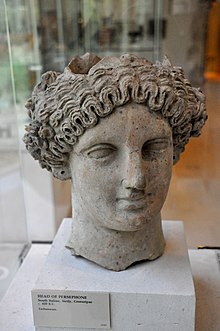
- Sicily
- Libya
Modern reception[]
Persephone also appears many times in popular culture. Featured in a variety of young adult novels such as Persephone[107] by Kaitlin Bevis, Persephone's Orchard[108] by Molly Ringle, The Goddess Test by Aimee Carter, The Goddess Letters by Carol Orlock, Abandon by Meg Cabot, and Lore Olympus by Rachel Smythe, her story has also been treated by Suzanne Banay Santo in Persephone Under the Earth in the light of women's spirituality. Here Santo treats the mythic elements in terms of maternal sacrifice to the burgeoning sexuality of an adolescent daughter. Accompanied by the classic, sensual paintings of Fredric Lord Leighton and William-Adolphe Bouguereau, Santo portrays Persephone not as a victim but as a woman in quest of sexual depth and power, transcending the role of daughter, though ultimately returning to it as an awakened Queen.[109]
See also[]
- Anthesphoria, festival honoring Proserpina, and Persephon
- Eleusinian Mysteries
- Rape of Persephone
- Sporus
Notes[]
- ^ The actual word in Linear B is

